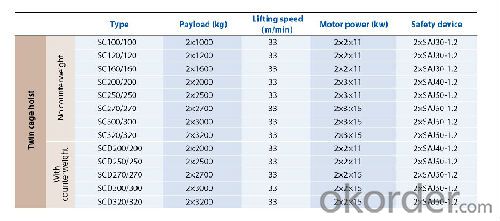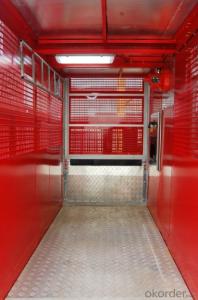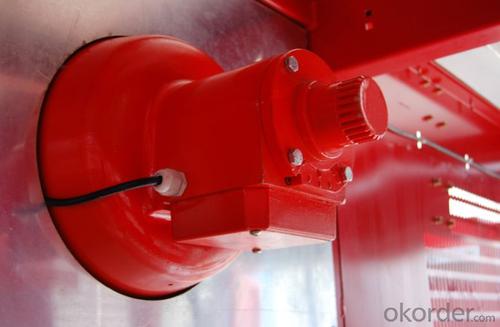YHX Building Hoist SC200
- Loading Port:
- Guangzhou
- Payment Terms:
- TT or LC
- Min Order Qty:
- -
- Supply Capability:
- 30 unit/month
OKorder Service Pledge
OKorder Financial Service
You Might Also Like
Construction Hoist Description:
The built-up hoist will be much more expensive, but will also be easier to repair and more durable. Package units were once regarded as being designed for light to moderate usage, but since the 60s this has changed. Built-up units are designed for heavy to severe service, but over the years that market has decreased in size since the advent of the more durable packaged hoist. A machine shop or fabricating shop will use an integral-package hoist, while a Steel Mill or NASA would use a built-up unit to meet durability, performance, and repairability requirements. NASA has also seen a change in the use of package hoists. The NASA Astronaut training pool, for example, utilizes cranes with packaged hoists.
Wire rope hoist or chain hoist
The more commonly used hoist in today's worldwide market is an electrically powered hoist. These are either the chain type or the wire rope type.
Construction Hoist Specification:

Construction Hoist Images:



FAQ of Building Hoist:
Q: What is the building hoist main purpose?
A: Building hoist equipped with double or single cabin to transport the materials and labors up and down. It's the ideal construction equipment for vertical transportation in the field of construction.
Q: What is the main structure of building hoist?
A: The P/M construction hoist mainly contains metal structure, driving system, electrical control system, cable guide & protection system, electrical top crane and safety device.
Q: What is the meaning of the building hoist’s code?
A: Take SC200/200 for example: “SC” stands for rack and pinion hoist, “200/200” stands for double cage and capacity is 2 tons per cage. “SC200” stands for single cage and capacity is 2 tons.
Q: What is the dimension of the cage?
A: Normally the cage dimension is 3X1.5X2.5M (L/W/H) for 2t type hoist. Details should be checked according to our quotation sheet. Also, the size can be customized according to the factual site condition. There are two doors (entrance & exit doors) for each cage, It can be produced as up & down sliding or ramping model for safety and convenience.
- Q: This question asks whether a building hoist can develop operational issues due to incorrect usage or lack of maintenance.
- <p>Yes, a building hoist can malfunction due to improper use or inadequate maintenance. Improper use may include overloading the hoist, using it in unsuitable conditions, or operating it without proper training. Inadequate maintenance can lead to wear and tear, lubrication issues, and component failures. Regular inspections, proper usage guidelines, and timely repairs are crucial to prevent malfunctions and ensure the safety of the hoist and its operators.</p>
- Q: Is it possible to use a manual building hoist to lift multiple objects simultaneously?
- <p>Yes, a manual building hoist can be used to lift multiple objects at once, provided the total weight does not exceed the hoist's maximum load capacity. It's crucial to ensure that the hoist is securely attached to a stable structure and that all safety protocols are followed to prevent accidents. The objects should be evenly distributed and properly secured to the hoist to maintain balance and prevent tipping. Always refer to the manufacturer's guidelines for specific weight limits and safety instructions.</p>
- Q: What are the specific safety mechanisms and controls that are typically incorporated into the design of a building hoist to ensure its safe operation?
- <p>Building hoists, also known as construction hoists, are equipped with several safety devices and controls to ensure safe operation. These include limit switches to prevent overtravel, safety locks that engage if the hoist sways excessively, emergency stop buttons for immediate cessation of movement, overload protection to prevent the hoist from lifting more than its capacity, and interlock systems that ensure the hoist cannot operate if a safety gate is open. Additionally, there are guardrails, toe boards, and anti-fall devices to protect workers from falling. Regular inspections and maintenance are also crucial for the safe operation of building hoists.</p>
- Q: How many meters or how many layers should the construction elevator be installed?
- Construction elevator is also called construction lifter, alias outdoor elevator or people dual-purpose ladder. The country is not clear how many meters or how many layer must be used, but in some coastal developed cities are now more than 30 meters using construction elevator, some cities also issued relevant rules more than 30 meters must use construction lifter, gantry and hoist is no longer used.
- Q: Is it possible to use a building hoist for the transportation of goods or materials?
- <p>Yes, building hoists are commonly used to transport goods and materials in construction projects. They are designed to lift and lower heavy materials such as bricks, cement, and tools, making the construction process more efficient and reducing the need for manual labor. Building hoists are equipped with safety features to ensure the secure transportation of materials, and they are an essential tool in many construction sites.</p>
- Q: Describe the key differences between electric and manual building hoists.
- <p>Electric building hoists are powered by electricity and can lift heavy loads quickly and efficiently. They are automated, reducing manual labor and increasing productivity. On the other hand, manual hoists require human effort to operate, making them slower and less efficient. They are less costly but demand more physical labor, which can lead to fatigue and potential accidents. Electric hoists are suitable for large-scale construction projects, while manual hoists are often used in smaller, more confined spaces where electricity might not be readily available or where the load is not excessively heavy.</p>
- Q: This question asks if a building hoist can be utilized for lifting both light and heavy objects.
- <p>Yes, a building hoist can be used for lifting both light and heavy objects. It is designed to handle a wide range of weights, depending on its capacity. Building hoists are engineered to lift materials such as bricks, concrete, and steel beams during construction. However, it's crucial to ensure that the hoist's lifting capacity is not exceeded to avoid accidents. Always check the manufacturer's specifications and safety guidelines before lifting any object with a building hoist.</p>
- Q: Is it possible to store lifting equipment in a residential setting such as a home or garage?
- <p>Yes, you can store your lifting equipment in your home or garage, but there are several considerations to keep in mind. Ensure that the space is dry, well-ventilated, and free from extreme temperatures to prevent rust or damage. Store equipment on stable, level surfaces to prevent tipping. Keep equipment away from children and pets for safety. Regularly inspect equipment for wear and tear, and store it properly when not in use to maintain its condition. Always follow the manufacturer's guidelines for storage to ensure the longevity and safety of your equipment.</p>
- Q: What are the primary materials that are commonly utilized in the construction of hoists?
- <p>Hoists are typically constructed using a combination of metals and synthetic materials for strength and durability. Steel, particularly alloy steel, is a common choice due to its high tensile strength and resistance to wear. Aluminum is also used for its lightweight properties, especially in mobile hoists. Synthetic materials such as nylon or polyester are used for hoist ropes and cables due to their resistance to abrasion and corrosion. Additionally, hoists may incorporate components made from brass, bronze, or other metals for specific parts that require low friction or high resistance to corrosion.</p>
- Q: Construction site construction elevator and tower crane, which unit security check and acceptance?
- Different but most likely is the construction elevator
Send your message to us
YHX Building Hoist SC200
- Loading Port:
- Guangzhou
- Payment Terms:
- TT or LC
- Min Order Qty:
- -
- Supply Capability:
- 30 unit/month
OKorder Service Pledge
OKorder Financial Service
Similar products
Hot products
Hot Searches
Related keywords



























